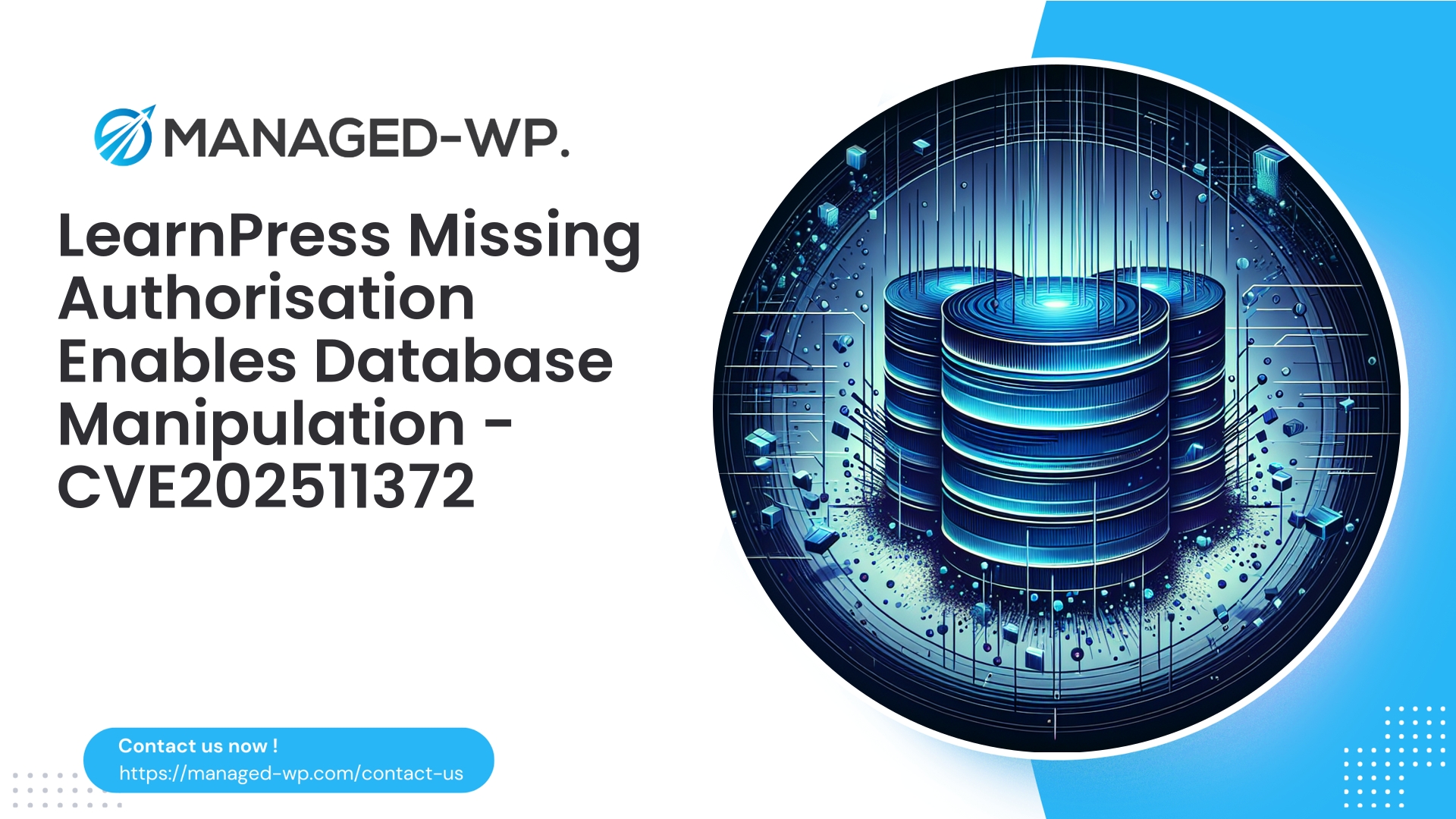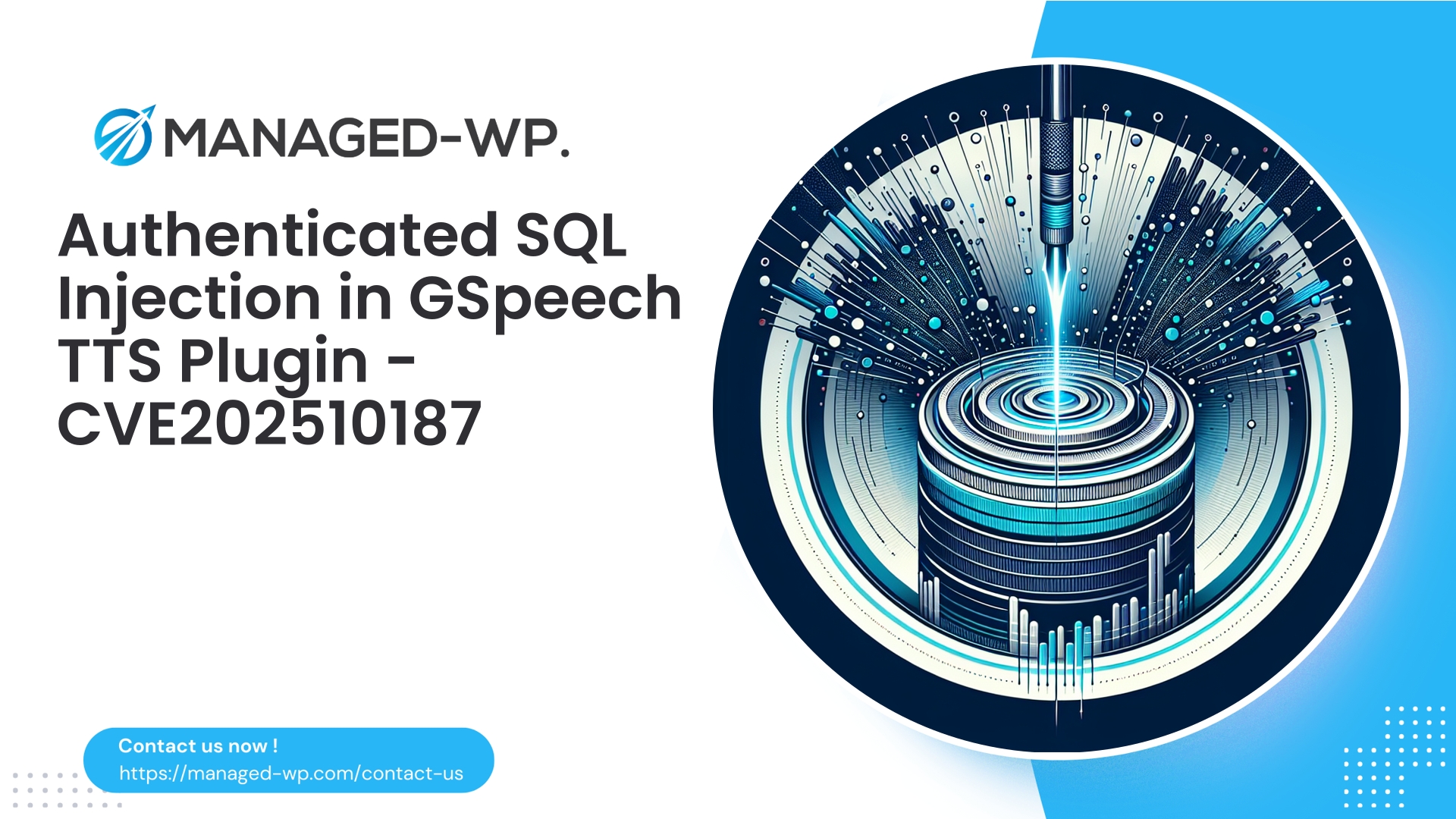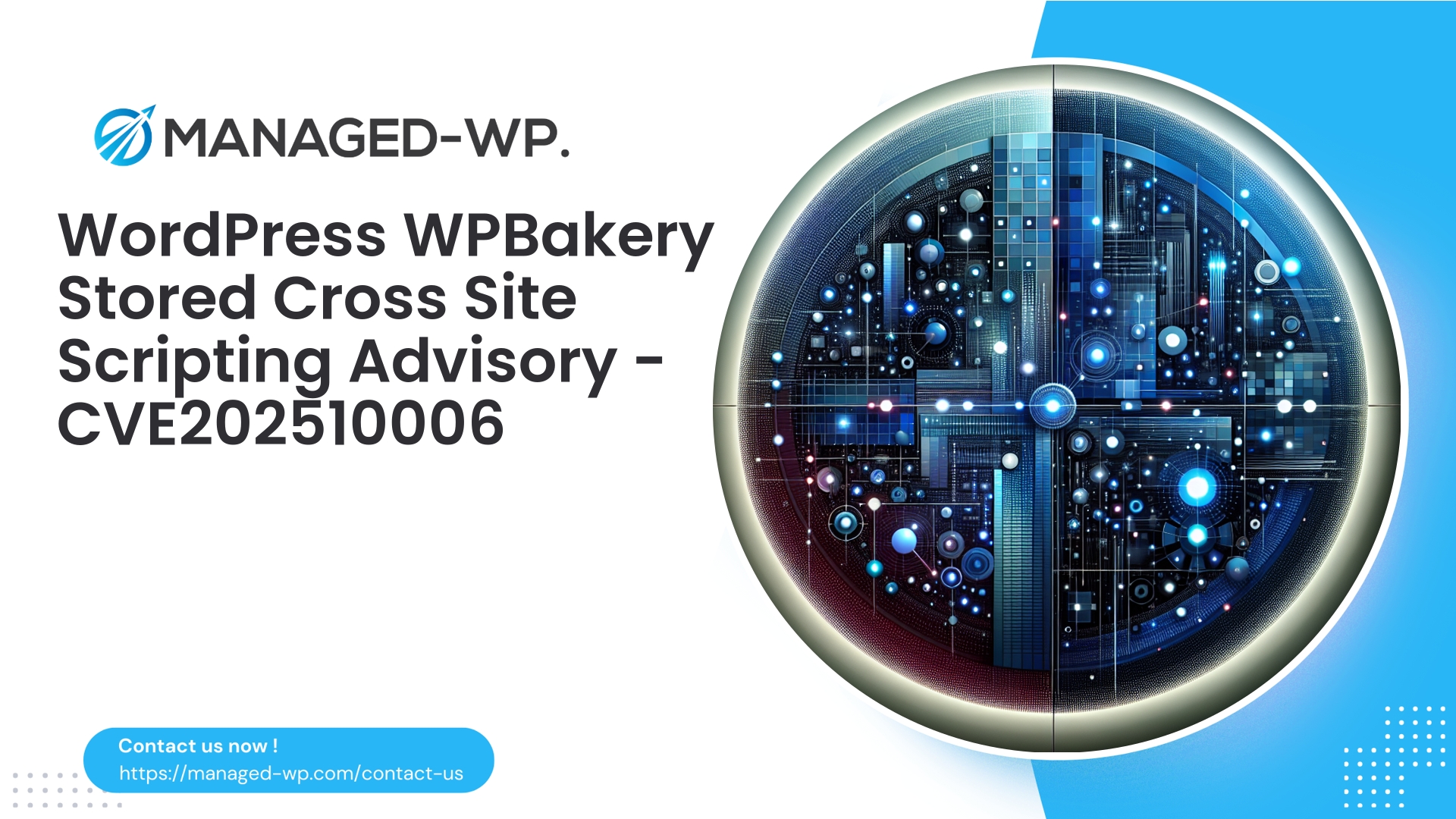| 插件名稱 | 學習出版社 |
|---|---|
| 漏洞類型 | 繞過授權 |
| CVE編號 | CVE-2025-11372 |
| 緊急 | 中等的 |
| CVE 發布日期 | 2025-10-18 |
| 來源網址 | CVE-2025-11372 |
LearnPress (≤ 4.2.9.3) 授權繞過漏洞 (CVE-2025-11372):網站所有者的關鍵措施
作者: 託管式 WordPress 安全專家
日期: 2025-10-18
執行摘要: LearnPress(版本≤4.2.9.3)中存在一個嚴重的“存取控制漏洞”,未經身份驗證的攻擊者可以利用該漏洞操縱 WordPress 資料庫。必須立即升級到 4.2.9.4 版本。對於無法及時更新的網站,必須採取諸如 Web 應用防火牆 (WAF) 規則和終端限制等緩解措施。本文將全面分析此威脅、潛在的利用方法、偵測指南、緩解策略,並根據美國網路安全最佳實踐提供逐步事件回應框架。
為什麼這種漏洞需要迅速應對
LearnPress 是一款受歡迎的 WordPress LMS 插件,它受到 CVE-2025-11372 漏洞的影響——該漏洞屬於存取控制缺陷,允許在未經身份驗證的情況下對資料庫進行未經授權的操作。主要細節包括:
- 受影響版本:LearnPress ≤ 4.2.9.3
- 已修復:LearnPress 4.2.9.4
- 嚴重程度:中(CVSS評分6.5)
- 攻擊途徑:無需登入(未經身份驗證)
缺乏授權檢查會大大擴大攻擊面。自動化掃描機器人會在漏洞公開後立即對其進行大規模測試,因此迅速採取行動至關重要。
在此背景下理解存取控制失效問題
存取控制失效是指系統未能正確執行權限控制。對於 LearnPress 而言,這表現為存在一個暴露的端點(可能是 AJAX、REST 或 admin-ajax),該端點會在未進行驗證的情況下處理輸入,從而導致資料庫變更:
- 使用者身份驗證狀態
- 使用者權限或角色
- 授權令牌或隨機數
這個漏洞使得攻擊者能夠執行未經授權的資料庫操作,例如創建、修改或刪除課程內容、註冊記錄和插件相關數據,從而加劇數據損壞、權限提升(透過虛假管理員帳戶)、網站篡改或完全接管等風險。
典型攻擊場景
根據網路安全情報,這些攻擊目標是合理的:
- 注入惡意內容以進行網路釣魚或搜尋引擎優化垃圾郵件活動
- 引入持久性後門或隱藏的管理員帳戶
- 透過偽造用戶元資料來提升權限
- 篡改或刪除關鍵的LMS記錄,以擾亂業務運營
- 偵察該地點,以便對該網站發動進一步攻擊。
由於無需任何憑證,攻擊者可以對存在漏洞的 WordPress 安裝發動大規模自動化攻擊。
網站管理員的緊急措施-一小時內必須完成的操作
如果您的網站使用 LearnPress,請將此事件視為高優先級安全事件:
- 立即將 LearnPress 更新至 4.2.9.4 版本 這是供應商提供的最終解決方案。對於多站點或代理商管理的環境,請緊急安排並部署更新,同時監控是否有異常行為。
- 如果無法立即更新,請暫時停用 LearnPress。 透過 WordPress 管理後台或 WP-CLI:
wp plugin deactivate learnpress
對於需要 LearnPress 功能的網站,請實施 WAF 或虛擬修補程式來阻止攻擊嘗試。 - 啟用WAF保護 — ManagedWP 客戶會收到針對此漏洞的即時規則更新。對於其他部署方式,請設定 WAF 以阻止對易受攻擊的端點和可疑有效負載的存取。
- 限制對插件端點的訪問 — 使用伺服器級控制(Apache 使用 .htaccess 文件,nginx 使用 config 檔案)來阻止或限制對插件 AJAX 或 REST 入口點的存取。 Apache 範例:
要求所有被拒絕請謹慎使用,並充分了解端點路徑。
- 增強日誌記錄和監控 — 啟用詳細的訪問日誌和錯誤日誌。密切注意異常的 POST 請求、不尋常的使用者建立模式以及未經授權的資料庫寫入。
- 通知內部團隊和利害關係人 漏洞狀況及正在採取的補救措施。
安全性更新指南
- 請務必在繼續操作前完整備份 WordPress 檔案和資料庫。
- 將網站置於維護模式,以防止更新期間影響使用者。
- 透過 WordPress 管理介面或 WP-CLI 更新 LearnPress:
wp 外掛程式更新 learnpress - 更新後,清除快取並驗證LMS核心功能是否完好無損。
- 請確認插件版本以確保補丁安裝成功:
wp plugin get learnpress --field=version - 如果發生更新問題,請先恢復備份並進行故障排除,然後再重試。
懷疑有漏洞利用時的取證檢查清單
- 保留所有相關日誌和備份。 進行深入分析。
- 搜尋入侵指標(IoC):
– 最近建立的管理員使用者:SELECT ID, user_login, user_email, user_registered FROM wp_users WHERE user_registered > '2025-10-18';
– 可疑的已發佈內容:
SELECT ID, post_title, post_date, post_author FROM wp_posts WHERE post_date > '2025-10-18' AND post_status='publish';
– wp_options 中存在不尋常的選項:
SELECT option_name, option_value FROM wp_options WHERE option_name LIKE '%learnpress%' OR option_name LIKE '%plugin_name%';
– 檢查 cron 作業、可寫入目錄中的新 PHP 檔案和出站連線日誌。
- 檢查文件完整性: 將外掛程式和主題文件與官方副本進行比較,以檢測未經授權的修改。
- 查看資料庫變更: 分析 LearnPress 表格中是否有異常行數或資料不一致的情況。
- 識別持久化機制: 檢查必須使用的外掛程式、選項、定時任務和新的管理員元資料。
- 輪換所有敏感憑證: 如果懷疑有篡改行為,請重設管理員密碼、API 金鑰和資料庫憑證。
- 補救措施: 清除受感染的安裝或從已知良好的備份中恢復,從可信任來源重新安裝核心和插件,並撤銷被洩露的憑證或金鑰。
如果您缺乏取證分析的專業知識或能力,請尋求專業事件回應資源的協助。
監測檢測模式
- 來自未知或可疑 IP 位址的異常 POST 請求,指向 admin-ajax.php、REST API 或關鍵插件端點。
- 來自同一來源的多個具有不同有效載荷的快速請求
- 在不規律的時間或大量情況下建立管理員用戶
- LearnPress 相關的意外大型資料庫寫入或新選項
- 在資料庫變更之前,多次出現有效的 HTTP 200 回應
實現以下警報:
- 建立新的管理員使用者帳戶
- 多次登入失敗後又成功登入
- 匿名 POST 請求到插件端點
- 上傳目錄或快取目錄中出現可疑的 PHP 文件
虛擬補丁建議
虛擬修補程式提供了一個臨時的保護層,可以在等待插件更新期間阻止攻擊嘗試。建議採取的措施包括:
- 阻止對特定易受攻擊端點的訪問,僅允許內部或受信任的 IP 位址存取。
- 拒絕包含可疑或意外資料結構的有效載荷,這些有效載荷的目標是該插件。
- 限制 LearnPress 端點的流量,以降低攻擊速度。
- 對於包含漏洞利用有效載荷參數的未經身份驗證的請求,傳回 HTTP 403 回應。
確保規則設定精準,避免干擾外掛程式的正常功能。
加強網站安全:長期安全最佳實踐
- 貫徹最小特權原則: 僅向必要的使用者授予管理員和插件特定角色。
- 移除或停用未使用的外掛程式和主題: 最大限度地減少攻擊面。
- 安全客製化開發: 實作嚴格的授權檢查、隨機數字驗證、預編譯 SQL 語句和資料清理。
- 加強檔案和伺服器權限: 防止在上傳過程中執行 PHP 程式碼,並確保最小寫入權限。
在 /wp-content/uploads 目錄下放置 .htaccess 檔案以阻止 PHP 執行。 - 啟用自動安全性更新: 適用於支援此功能的關鍵插件。
- 保持嚴格的備份和復原協定: 定期測試修復程序。
- 實施集中式日誌記錄和主動監控: 使用 SIEM 或其他工具追蹤異常活動。
- 安排例行安全評估: 包括程式碼審查和漏洞掃描。
補丁後監測和警戒
- 查看補丁應用程式之前的日誌,尋找漏洞利用跡象。
- 監控SEO分析和搜尋控制台數據,以發現異常的內容變化。
- 注意觀察是否有重複出現的可疑檔案或配置,這些都可能表示攻擊者試圖再次發動攻擊。
- 保持持續的漏洞掃描和修補程式管理。
事件回應手冊:概要
- 確認: 確認受影響的外掛程式和版本(LearnPress ≤ 4.2.9.3)。
- 包含: 更新或停用外掛程式;應用WAF規則;如果確認有漏洞,則隔離系統。
- 根除: 清除惡意程式、未經授權的使用者和後門;從經過驗證的來源重新安裝核心元件。
- 恢復: 必要時從乾淨的備份中恢復;驗證完整性;加固配置。
- 經驗教訓: 記錄事件時間軸、根本原因,並改善防禦措施(自動化、監控、防火牆規則)。
常見問題解答
問: 我可以在準備更新的同時繼續使用 LearnPress 嗎?
一個: 如果立即更新不可行,則應用嚴格的 WAF 規則來阻止易受攻擊的端點,透過 IP 或基本身份驗證限制訪問,並加強監控,直到部署更新為止。
問: 更新後是否需要額外掃描?
一個: 當然。更新修補程式可以修復漏洞,但無法撤銷攻擊者先前的任何操作。務必進行徹底的完整性審查和資料庫審查。
問: 卸載 LearnPress 比打補丁更安全嗎?
一個: 卸載未使用的插件是最佳做法。對於業務關鍵型 LearnPress 部署,請及時更新並套用建議的加固和監控措施。
需要調查的入侵指標 (IoC)
- 意外的管理員使用者帳戶或最近註冊的具有提升權限的使用者帳戶
- LearnPress 特定資料庫表中出現無法辨識或可疑的條目
- 不熟悉的定時任務引用插件檔案或晦澀的回調函數
- 上傳檔案、快取檔案或外掛程式目錄中的 PHP 檔案經過混淆處理
- 來自臨時 IP 位址的快速或重複 POST 請求,目標位址為 admin-ajax.php 或 REST 端點
用於調查可疑活動的推薦 SQL 查詢
對資料庫執行以下唯讀查詢(如果表前綴不同,請進行相應調整):
- 最近建立的管理員使用者:
SELECT ID, user_login, user_email, user_registered FROM wp_users WHERE user_registered >= '2025-10-18' ORDER BY user_registered DESC;
- 近期發布的文章/頁面:
SELECT ID, post_title, post_type, post_date, post_status FROM wp_posts WHERE post_date >= '2025-10-18' ORDER BY post_date DESC;
- 可用於持久化的選項:
SELECT option_name, option_value FROM wp_options WHERE option_name LIKE '%learnpress%' OR option_name LIKE '%_backdoor_%' LIMIT 200;
- 貼文或上傳內容中引用的 PHP 檔案:
SELECT guid FROM wp_posts WHERE post_mime_type='application/x-php' OR guid LIKE '%.php%';
警告: 務必格外謹慎,除非確定其影響,否則避免執行破壞性查詢。
Managed-WP 如何支援您的安全計劃
Managed-WP 專注於 WordPress 安全,並提供進階保護層,以減少您在 CVE-2025-11372 等漏洞期間的風險暴露時間:
- 提供最新的託管式 WAF 規則來源,旨在防止未經身份驗證的端點和惡意負載的攻擊。
- 虛擬修補可在無需立即更改程式碼的情況下阻止攻擊
- 全面的惡意軟體掃描,可自動偵測後門和注入程式碼
- 持續監控並發出關鍵指標警報,例如未經授權的管理員建立和異常的插件資料庫活動。
- 專家指導下的補救援助和事件回應支持
透過 Managed-WP 快速部署有針對性的邊緣規則可以顯著降低風險和停機時間。
Managed-WP 基本(免費)保護入門指南
免費的基本安全保障
對於需要在計劃更新或調查期間立即採取經濟有效的防禦措施的網站,Managed-WP Basic(免費)計劃提供:
- 具有無限吞吐量的託管防火牆,用於過濾可疑流量
- WordPress優化型Web應用程式防火牆(WAF)
- 惡意軟體掃描,用於偵測惡意軟體和有效載荷
- 針對 OWASP 主要威脅的緩解措施
立即註冊,以便在更新 LearnPress 或進行取證分析時保護您的網站安全:
https://my.wp-firewall.com/buy/wp-firewall-free-plan/
對於自動惡意軟體清除和漏洞虛擬修補等高級功能,請考慮 Managed-WP 的高級套餐。
網站所有者最終安全檢查清單
- 立即將 LearnPress 更新至 4.2.9.4 版本。
- 如果無法及時更新,請停用該外掛程式或強制執行嚴格的 WAF 規則,阻止易受攻擊的端點。
- 在進行任何更新之前備份所有站點數據,並保留日誌和資料庫快照至少 30 天。
- 進行完整性檢查和資料庫審計,以檢測潛在的安全漏洞。
- 輪換所有憑證並審核 API 和整合金鑰。
- 對管理員和外掛角色實施最小權限原則。
- 部署持續監控工具,包括WAF和惡意軟體掃描。
Managed-WP 安全專家的閉幕致辭
諸如 CVE-2025-11372 之類的漏洞凸顯了 WordPress 生態系統中主動修補漏洞和快速安全事件回應的緊迫性。從漏洞公開到自動漏洞掃描之間的時間窗口非常短暫——每一小時都至關重要。
Managed-WP 致力於為網站所有者和管理員提供及時有效的保護,包括虛擬補丁和專家級事件處理。我們的基礎(免費)套餐可在您進行補丁修復和調查期間,為您提供即時的防禦層。
保持警惕,做好備份,果斷行動。
— Managed-WP 安全團隊



















